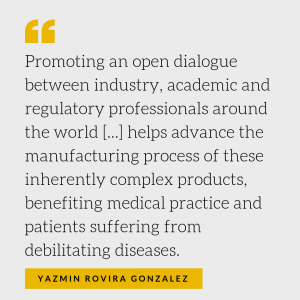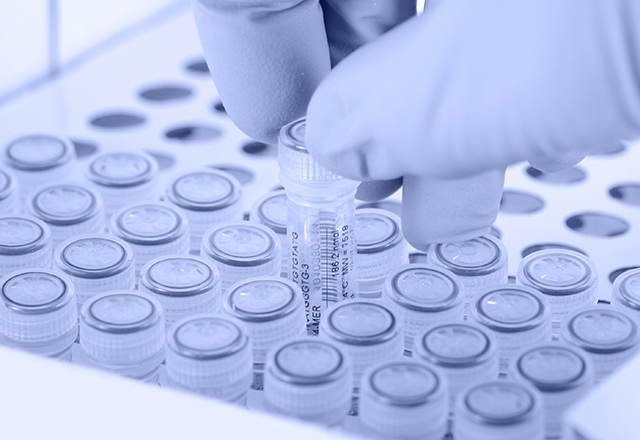Cellular and gene therapy-related research in the United States is growing at a fast pace, with many products moving forward in clinical development. Applications of these cellular and gene therapies range from using a person’s own cells and genetically altering them to fight cancer, to replacing a gene in the eye to restore vision in patients with an inherited genetic defect. The ability to introduce DNA into a patient to directly treat a genetic disease (gene therapy) or inject them with cellular material (cell therapy) in an attempt to cure disease distinguishes cellular and gene therapy from more traditional chemical drugs.
To date, there are 16 FDA-approved cellular and gene therapy products, and three of them — Kymriah, Yescarta and Luxturna — were licensed just last year (2017), reflecting the rapid advancements in this field. Kymriah, a treatment where T-cells are engineered to attack cancer, and Luxturna, a one-time gene therapy for individuals with an inherited retinal disease, are both great examples of how cell and gene therapies are being used today. Although the potential applications of these therapies are being studied in many areas — including genetic disorders, autoimmune diseases and cancer — the academic and research communities still have much to learn about how these products work, how to administer them safely and how to manufacture them on a reasonably sized scale without lessening their quality.
 Given the need for a global open forum to discuss such problems and facilitate biopharmaceutical development and regulation in this emerging field, the professional scientific society CASSS-Sharing Science Solutions (CASSS) launched the first three-day meeting of Cell & Gene Therapy Products (CGTP): Manufacturing, Quality and Regulatory Considerations on July 10, 2018, co-chaired by Bruce Thompson from the Fred Hutchinson Cancer Research Center and Andrew Weiskopf from Biogen. From the time it opened early in the morning, the hall was packed with excitement as hundreds of researchers and regulators from around the world came together to talk about technical and scientific advances related to manufacturing, quality and regulatory considerations of these novel products.
Given the need for a global open forum to discuss such problems and facilitate biopharmaceutical development and regulation in this emerging field, the professional scientific society CASSS-Sharing Science Solutions (CASSS) launched the first three-day meeting of Cell & Gene Therapy Products (CGTP): Manufacturing, Quality and Regulatory Considerations on July 10, 2018, co-chaired by Bruce Thompson from the Fred Hutchinson Cancer Research Center and Andrew Weiskopf from Biogen. From the time it opened early in the morning, the hall was packed with excitement as hundreds of researchers and regulators from around the world came together to talk about technical and scientific advances related to manufacturing, quality and regulatory considerations of these novel products.
Early-stage manufacturing considerations for cellular and gene therapies were the focus of Day One of the conference. Thomas Finn, product reviewer for the FDA’s Center for Biologics Evaluation and Research, discussed general manufacturing concerns when it comes to cell and gene therapies. For example, some risks are common to all cell and gene therapies (e.g., support materials, facilities, sterile processing, etc.), while others are exclusive to certain types of products (research samples from a single source versus large-scale multisource cell bank). He proposed that early product development should progress in the following order:
- How is the product supposed to work in the patient? The goal here is to figure out the function or change resulting from exposing the subject to a product (mode of action).
- What would you have to study clinically to evaluate safety and efficacy based on mode of action? What properties does the product need? This step aims to establish the product’s attributes so that they can be communicated clearly to all interested parties (e.g., regulatory authorities, patients, etc.).
- What critical properties need to be controlled to achieve the desired safety and potential efficacy? In other words, what are the physical, chemical, biological or microbiological properties or characteristics that should be within an appropriate limit, range or distribution to ensure desired product quality?
- What processes need to be controlled to achieve the desired safety and potential efficacy? Since variability in methods/techniques has an impact on the product’s quality, all processes should be monitored or controlled to ensure they don’t negatively impact the final product.
- What elements are needed to achieve a consistent process? The last step is to focus on other manufacturing factors that may not be critical for maintaining the product’s properties but that need to be tightly monitored to guarantee consistency within the manufacturing process.
Continuing with Day Two of the meeting, the FDA announced three new draft guidance documents on the development of gene therapy products for hemophilia, rare diseases and retinal disorders. The FDA also issued three new and comprehensive updates to three existing guidance documents that were first issued in April 2008. The field of human gene therapy has progressed rapidly since then, so these updates were much awaited by many sponsors. The new regulations address manufacturing issues related to gene therapy, including long-term follow-up observational studies that collect data on adverse events, testing retroviral vector-based human gene therapies, and chemistry, manufacturing and control (CMC) information. Taken together, these six modern guidance documents will hopefully help researchers and industries gather all evidence necessary to prove the effectiveness of new drugs, including cell and gene therapies.
Lastly, Day Three of the conference focused on discussing the quality of basic materials from which biologics are made (raw materials) and on considerations to be taken when comparing these products to available standards.
Human cell and gene therapies represent two opportunities with high potential for developing very effective and possibly corrective treatments for many vexing disorders, such as cancer, cystic fibrosis, heart disease, hemophilia and diabetes. Promoting an open dialogue between industry, academic and regulatory professionals around the world via conferences like this one helps advance the manufacturing process of these inherently complex products, benefiting medical practice and patients suffering from debilitating diseases.
Throughout the conference, networking opportunities abounded between experts and aspiring students, forming valuable connections. If you are a graduate student at Johns Hopkins interested in a professional career in industry, the Johns Hopkins Professional Development and Career Office (PDCO) has partnered with CASSS to match graduate students with an industry mentor to meet monthly for a total of six months with the goal of mentoring students on transitioning to careers in industry. Mentors from both small and large companies as well as regulatory agencies volunteer to help students by discussing career interests, resume and skillset, elevator pitch and current trends in their field of interest to become exceptional candidates for industry jobs. The CASSS-JHU Mentor Match Program plans on enrolling a new cohort of students in the fall, so keep an eye out for an email from PDCO, or contact Caroline Pounds at [email protected] for more details about the program!
